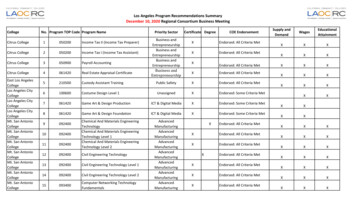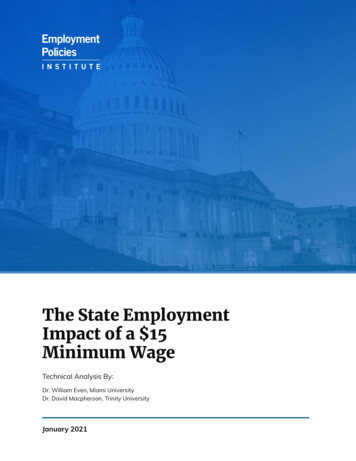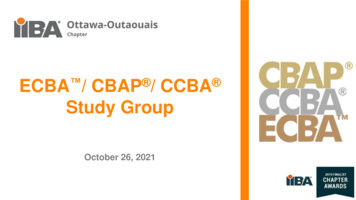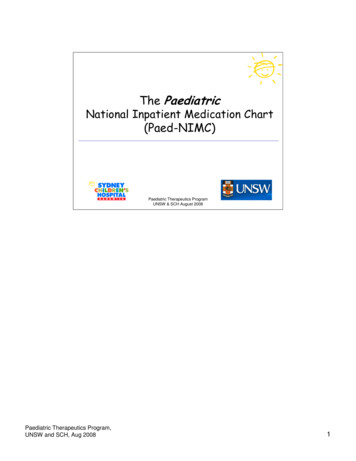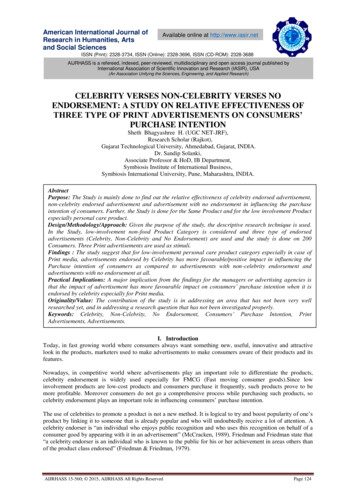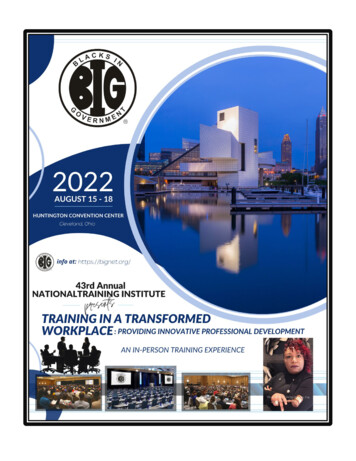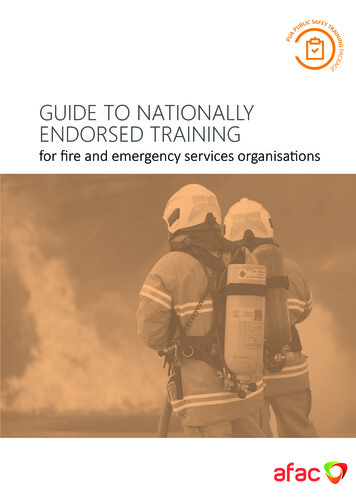
Transcription
PUAG PACKANINGAISAFEYTRBLICUPEGUIDE TO NATIONALLYENDORSED TRAININGfor fire and emergency services organisations
ACKNOWLEDGEMENTSThe Australasian Fire and Emergency Services Authorities Council (AFAC) expresses its gratitudeto the authors David Rawet and Sandra Lunardi on the development of this resource, RebeccaDuffy for the editing of this resource and Nicola Laurence for the editing, design and layoutof this resource. AFAC would also like to thank Deborah Parsons from the South AustraliaMetropolitan Fire Service, and Amanda Nabi from the Department of Biodiversity, Conservationand Attractions (WA) for providing examples of training and assessment strategies used withintheir organisations. Thanks also to those members of the AFAC Learning and DevelopmentGroup and Cassandra Curtis (Chair) that provided feedback on the Guide content.Guides produced by the Community Service and Health Industry Skills Council were useful indeveloping the structure and content of this Guide.DISCLAIMERThis document has been developed from consultation and research between the AustralasianFire and Emergency Service Authorities Council Limited (AFAC), its members and stakeholders.It is intended to address matters relevant to fire, land management and emergency servicesacross Australia, New Zealand and the Pacific region.The information in this document is for general purposes only and is not intended to be usedby the general public or untrained persons. Use of this document by AFAC Member agencies,organisations and public bodies does not derogate from their statutory obligations. It isimportant that individuals, agencies, organisations and public bodies make their own enquiriesas to the currency of this document and its suitability to their own particular circumstancesprior to its use.AFAC does not accept any responsibility for the accuracy, completeness or relevance of thisdocument or the information contained in it, or any liability caused directly or indirectly by anyerror or omission or actions taken by any person in reliance upon it.Copyright 2019, Australasian Fire and Emergency Service Authorities Council LimitedAll rights reserved. Copyright in this publication is subject to the operation of the CopyrightAct 1968 and its subsequent amendments. Any material contained in this document can bereproduced, providing the source is acknowledged and it is not used for any commercialisationpurpose whatsoever without the permission of the copyright owner.Australasian Fire and Emergency Service Authorities Council Limited(ABN 52 060 049 327)Level 1, 340 Albert StreetEast Melbourne Victoria 3002Telephone: 03 9419 2388Facsimile: 03 9419 2389afac@afac.com.auafac.com.auCover photo: Sourced from MFB
TABLE OF CONTENTSCHAPTER 1: LEARNING PROGRAMS31.1 Learning programs31.2 Learning programs using nationally endorsed material31.3 Structure of national units of competency41.4 Trainer and assessor requirements51.5 Validating learning materials61.6 Use of elective units61.7 RTO requirements71.8 Training for people with a disability101.9 Reasonable adjustment11CHAPTER 2: RESOURCES122.1 Key industry bodies122.2 Glossaries142.3 Research products142.4 Vocational Educational Eudcation and Training (VET) framework products162.5 VET regulatory authorities172.6 Training package development172.7 VET links18CHAPTER 3: FEEDBACK AND REFERENCES193.1 Feedback193.2 References19AFAC GUIDE TO NATIONALLY ENDORSED TRAINING I 1
PURPOSE OF THIS GUIDEThis Guide to Nationally Endorsed Training is one of several guides produced to help with thedevelopment and delivery of learning materials for the fire and emergency services sector, and withimplementation of the Public Safety Training Package.This Guide is developed to provide an overview of the nationally endorsed training systems and componentssuited to: trainers assessors training designers and developers training managers.PUA Public SafetyTraining PackageAssessmentStrategies GuideLearningStrategies GuideGuide toNa onallyEndorsed TrainingA Guideon FAQsI 2
CHAPTER 1: LEARNING PROGRAMSCHAPTER 1:Learning programs1.1 LEARNING PROGRAMSFire and emergency service organisations use a rangeof learning programs which vary widely in their extent,complexity and how they relate to specific job roles.Learning programs can include: non-endorsed short courses designed for specificknowledge, skill or role requirements single units of nationally endorsed materialdesigned for specific knowledge, skill or rolerequirements multiple units of nationally endorsed materialdesigned for specific role requirements. Thesemay be packaged together as nationally endorsedor agency-designed skill sets multiple units of nationally endorsed materialleading to national qualifications. These maysupport one or more role requirements agency required content not described innational units but may occur in programswhen it is required for performance of theagency’s job roles.The strategies supporting effective learning apply toall learning programs irrespective of whether theycarry national endorsement or not. There are specificrequirements, however, when nationally endorsedmaterial is presented.1.2. LEARNING PROGRAMS USINGNATIONALLY ENDORSED MATERIALA large proportion of the learning delivered to fireand emergency service organisations is drawn fromnationally endorsed material, specifically the PublicSafety Training Package. This package and its contentis often referred to by the letters ‘PUA’, which arethe prefix codes to all Public Safety Training Packagequalifications and units.PUA content includes endorsed and companionmaterial, which together are designed to enableRegistered Training Organisations (RTOs) to delivertraining in an effective and compliant manner. Trainingand assessment conducted by RTOs must comply withthe Standards for Registered Training Organisations(RTOs) 2015. These standards are referencedthroughout this document and the Learning Strategiesand Assessment Strategies Guides.Each training package is comprised of threecomponents:1. Units of competency: define the skills andknowledge to operate effectively and how theyneed to be applied to perform effectively in aworkplace context.2. Qualifications framework: groups of units ofcompetency ranging from Certificate I to GraduateDiploma level.3. Assessment guidelines: the industry’s preferredapproach to assessment, including thequalifications required by assessors, the designof assessment processes and how assessmentsshould be conducted.Skills Services Organisations (SSOs) are required topublish a Companion Volume Implementation Guidewhen they revise a training package. The CompanionVolume Implementation Guide is designed to helpproviders implement the training package and containsinformation such as: version control and modification history mapping information explaining whether theoutcomes of the new products are equivalent,or not equivalent to the superseded products regulation and licensing implications forimplementation mandatory entry requirements, pathwaysadvice and access and entry conditions resource and equipment lists links to learning strategies, knowledge andassessment guidance, if relevant.AFAC GUIDE TO NATIONALLY ENDORSED TRAINING I 3
CHAPTER 1: LEARNING PROGRAMSThis Guide meets the need identified in the last dotpoint above. PUA units of competency, assessment requirements,qualifications and skill sets can be found on theNational Register of VET: www.training.gov.au.1.3 STRUCTURE OF NATIONAL UNITS OFCOMPETENCYNational units of competency are written using aconsistent template. Each unit has two associateddocuments:1. a description of the competency2. a description of the unit’s assessmentrequirements.1.3.1. Components of national units ofcompetencyEach unit is made up of 11 components, including:UNIT CODEThe unit code contains the three alpha charactersidentifying the Training Package, followed by alpha ornumeric characters. It must comply with the lengthspecified in the AVETMIS Standard (no more than12 characters).UNIT TITLEThe title concisely describes the unit outcome.It must comply with the length specified in theAVETMIS Standard (no more than 100 characters).MODIFICATION HISTORYHistory of this and previous releases of equivalent units.the unit of competency’s relationship to anylicensing, legislative, regulatory or certificationrequirements. Where no requirements exist,insert: No licensing, legislative or certificationrequirements apply to this unit at the time ofpublication.UNIT SECTOR (OPTIONAL)Used only when the Training Package developer wishesto categorise a set of units within a Training Package inrelation to an industry sector.ELEMENTSElements describe the essential outcomes.PERFORMANCE CRITERIAPerformance criteria describe the performance neededto demonstrate achievement of the element.FOUNDATION SKILLSThis section describes language, literacy, numeracy andemployment skills incorporated in the performancecriteria that are required for competent performance.Where all foundation skills essential to performance inthis unit are explicit in the performance criteria insert:Foundation skills essential to performance are explicit inthe performance criteria of this unit of competency.UNIT MAPPING INFORMATIONSpecifies code and title of any equivalent unit ofcompetency. If no equivalent insert: No equivalent unit.LINKSLink to Companion Volume Implementation Guide.PREREQUISITE UNITList any unit(s) in which the candidate must be deemedcompetent prior to the determination of competency inthis unit.1.3.2. CompetencyAPPLICATIONThe application section briefly describes how theunit is practically applied in the industry and in whatcontext(s) the unit may be applied. It Includes:MODIFICATION HISTORYHistory of this and previous releases of equivalent units. a summary statement of unit content focused, useful information on how and where theunit of competency could be practically applied andwho might use itI 4There are four main components of assessmentrequirements for national units of competency,which are:PERFORMANCE EVIDENCE specifies the required product and process evidence specifies the frequency and/or volume of product/process evidence specifies the relationship between the product andprocess evidence and the performance criteria.
KNOWLEDGE EVIDENCE specifies what the individual must know to safelyand effectively perform the work task described inthe unit of competency relates directly to the performance criteria and/orrange of conditions indicates the type and depth of knowledgerequired to meet the demands of the unit ofcompetency.ASSESSMENT CONDITIONS stipulates any mandatory conditions forassessment specifies the conditions under which evidencefor assessment must be gathered, including anydetails of equipment and materials, contingencies,specifications, physical conditions, relationshipswith team members and supervisor, relationshipwith client/customer, and timeframespecifies assessor requirements, including anydetails related to qualifications, experience andindustry currency.Professional development means activities that developand/or maintain an individual’s skills, knowledge,expertise and other characteristics as a trainer orassessor. This includes both formal and informalactivities that encompass vocational competencies,currency of industry skills and knowledge and practiceof vocational training, learning and assessment,including competency-based training and assessment.Examples of professional development activitiesinclude:1. participation in courses, workshops, seminars,conferences, or formal learning programs2. participation in mentoring, professionalassociations or other learning networks3. personal development through individualresearch or reading of publications or otherrelevant information4. participation in moderation or validation activities5. participation in industry release schemes.Maintaining currency and competence is promoted by: visiting work sites: trainers and assessors regularlyattend work sites to supervise and observelearners, consult with workplace supervisors andobserve work operations and conditions; all tasksthat provide opportunities to keep up-to-date withindustry practice1.4. TRAINER AND ASSESSORREQUIREMENTS work site placements: encourage trainers andassessors to take up industry placements within oroutside their own organisation1.4.1. Trainer and assessor qualifications working closely with industry representatives:bringing industry people in as guest speakers,as observers of class activities, or to meet withtrainers to discuss real life situations wherecompetencies are required and to work with theRTO personnel to create realistic scenarios thatstudents can learn fromLINKSLink to Companion Volume Implementation Guide andany other relevant information.Trainers and assessors (including those assistingin training) must hold the training and assessmentcredentials specified in the Standards for RTOs.Those requirements change from time to time andreference to the current version of the Standards isessential to ensure compliance.1.4.2. Maintaining currencyUnder the Standards for Registered TrainingOrganisations (RTOs) 2015, all trainers and assessorsneed to maintain currency and competency in theunits they deliver. They need to undertake professionaldevelopment in the fields of the knowledge andpractice of vocational training, learning and assessmentincluding competency-based training and assessment.The regulators of RTOs provide further informationabout what is required to achieve and maintainvocational competency: ASQA – www.asqa.gov.au/ VRQA – www.vrqa.vic.gov.au/Pages/default.aspx WATAC – www.tac.wa.gov.au/Pages/default.aspxAFAC GUIDE TO NATIONALLY ENDORSED TRAINING I 5
CHAPTER 1: LEARNING PROGRAMS1.5. VALIDATING LEARNING MATERIALSAnother requirement of the Standards for RegisteredTraining Organisations (RTOs) 2015 is the need forlearning materials to be validated by industry. This canbe achieved in different ways: formal meetings or validation sessions online forums direct feedback during industry site visits.Each training product must be validated at least onceevery five years. Those validating the material mustcollectively have: vocational competencies and current industry skillsrelevant to the assessment being validated current knowledge and skills in vocational teachingand learning the training and assessment credentials specifiedin the Standards for RTOs.Validators are not permitted to validate instances ofdelivery or assessment in which they were directlyinvolved.The ASQA website also contains a fact sheet aboutindustry validation: g-validation1.html1.6. USE OF ELECTIVE UNITSDepending on the qualification there may be few ormany elective options listed. For RTOs, it may notbe feasible or desirable to have all elective optionsavailable to learners. For enterprise RTOs (such asfire and land management agencies), the inclusion ofelectives should reflect the workplace needs of theenterprise. The electives available to learners are thosethat must be listed in the Training Assessment Strategy.To the extent that elective options permit, learners canselect electives that reflect their vocational interests,role requirements or professional development goals.The packaging rules of a qualification offer optionsand learners should be guided to select units ofcompetency that: are identified by industry as needed skill areasand will, therefore boost their chances of gainingmeaningful employment are areas of interest for personal and professionaldevelopment to the learnerI 6 relate to prospective or current job roles andresponsibilities can lead to specialisation or further study.Where providers limit the range of electives, theyshould always ensure prospective learners knowthey may have other options with other RTOs andexplain why the elective range has been both limitedand chosen.EXAMPLESPUA30613 CERTIFICATE III IN PUBLIC SAFETY(FIREFIGHTING AND EMERGENCY OPERATIONS)The qualification has eight core and four elective unitsof competency, with up to two of those electives ableto be selected from within the PUA Training Package,another endorsed training package or accreditedcourse.There is a wide range of diversity within thequalification’s electives. Many are specialised in natureand may not be relevant to all enterprises or practicalfor all RTOs to offer.PUA30713 CERTIFICATE III IN PUBLIC SAFETY(FIREFIGHTING OPERATIONS)The qualification has three core and nine elective unitsof competency, with up to two of those electives ableto be selected from within the PUA Training Package,another endorsed training package or accreditedcourse.The electives are assembled in groups to ensure thosecompleting this qualification address specific skill areasand develop a broad range of skills to work effectivelyin the industry. Again, there is a wide range of diversitywithin the qualification’s electives. Many are specialisedin nature and may not be relevant to all enterprises orpractical for all RTOs to offer.PUA60913 ADVANCED DIPLOMA OF PUBLICSAFETY (FIRE INVESTIGATION)The qualification has 12 core and three elective unitsof competency, with up to two of those electives ableto be selected from within the PUA Training Package,another endorsed training package or accreditedcourse.
The electives are assembled in two groups to ensurethose completing this qualification address specific skillareas. The number and range of electives offered withinthe qualification is quite narrow due to the quantityof core learning required for the role the qualificationsupports.PUA60513 ADVANCED DIPLOMA OF PUBLICSAFETY (FIREFIGHTING MANAGEMENT)The qualification has four core and seven elective unitsof competency, with up to two of those electives ableto be selected from within the PUA Training Package,another endorsed training package or accreditedcourse.Electives are grouped and selection of units withinGroup A is limited to ensure the qualifications gainedare appropriate to the industry sector learners areworking in or working towards. Remaining electivesaddress a range of managerial activities.Jurisdictional requirements vary and RTOs shouldresearch and confirm current requirements beforedelivery. This also applies to specialised units.In all cases, individual units of competency have varyinglevels of complexity and task autonomy. The process ofqualification development has ensured core units areappropriate for the nominated job roles. RTOs need tomake judgments about the appropriateness of electiveunits for those job roles, especially where these arechosen from outside the qualification elective listings orfrom another training package.RTOs should never base elective decisions on the unitof competency title alone and a detailed review ofcontent is required to make an informed judgementabout the most appropriate unit to select.The application statement in the unit of competencyshould provide a clear indication about content andscope.1.6.1. Factors contributing to elective choice1.7. RTO REQUIREMENTSSPECIALISATIONSSome qualifications allow for different specialisations.By choosing appropriate combinations of units, anindividual may complete the program with one or morespecialisations identified in the qualification.All accredited training against the training package,as outlined in the Standards for Registered TrainingOrganisations 2015, must be carried out by an RTO: training package qualifications or specific units ofcompetency in its of delivery, orQualifications may allow the option of choosingelectives to specialise in one or more areas. See therelevant qualification documents for more information. works in partnership with another RTO that does.In choosing a specialisation, the RTO (and theindividual) must make sure it will be possible to achievecompetency in that area. Often, the units requireat least some assessment to be undertaken in theworkplace. The workplace must therefore, be able tooffer the opportunity for the student to gain experiencewithin the area of work most relevant to the unit ofcompetency. The Assessment Conditions, within theAssessment Requirements for each unit of competency,states where the assessment must take place andany other conditions. The availability of relevant workplacement opportunities may in some cases constrainelective choice.REGULATORY REQUIREMENTSAll units must be considered in the context ofregulatory requirements in the particular jurisdictionthey are being used. While RTOs must be aware ofrequirements for all units they deliver, there are someunits where care needs to be taken.The same standards specify all providers must havetraining and assessment strategies and practices inplace that are responsive to industry and learner needsand meet the requirements of training packages andVET accredited courses (Standard 1).A training and assessment strategy (TAS) is anorganising framework for the delivery of a unit ofcompetency, a group of units or a qualification.It provides an overview about how components oftraining packages can be delivered and may also includeinformation about pathways and training materials.A typical learning strategy would include: information about the learner group and theircharacteristics and needs the selection of units of competency or aqualification with electives identified, as definedby the packaging rules options for structuring delivery including broadcontent structureAFAC GUIDE TO NATIONALLY ENDORSED TRAINING I 7
CHAPTER 1: LEARNING PROGRAMS pathways for learners delivery approaches (on the job, off the job,blended) assessment information staffing operational requirements.COMPONENTS OF TRAINING AND ASSESSMENTSTRATEGIESRTOs should address, at minimum, the following areasin each strategy:Training product Ensure the training product to which the strategyrelates is clearly identified.1.7.1. Training and assessment strategy (TAS) The User’s Guide to the Standards for RTOs providesguidance for the development of a TAS. The followingmaterial is taken from the User’s Guide to the Standardsfor RTOs (pp. 40–42).Core and elective components (full qualifications)If delivering a full qualification, identify core andelective components in accordance with the structuredefined in the training package or course.RTOs must develop a strategy for training andassessment for each training product it is registeredto deliver. The format for these strategies can bedetermined by the RTO. RTOs may need to developdifferent strategies for different delivery modes ortarget groups/student cohorts.A training and assessment strategy may comprisemultiple documents, however, there must beconsistency between these documents to ensurethe overall strategy is clearly described.Strategies for training and assessment should not be‘static’. Each strategy needs to be regularly updatedto consider: changes in industry technology and techniques,legislation and the training package itself the availability of resources within the RTO.The strategies must also be consistent with anyadvertising and other material provided to prospectivestudents.Specific requirements may be set, such as requiringstudents to have a minimum period of industryexperience before they can commence the program.If specific requirements are set, these must be clear toprospective students prior to enrolment.In relation to monitoring and evaluating training andassessment strategies and practices, while each RTOcan decide on its own process, evidence is requiredto show: I 8monitoring and review of training and assessmentin a systematic wayresults are used to revise systems and practiceswhere needed.Include the code and full title to ensure clarity.Define which elective units or modules are beingoffered for effective planning for all delivery variables.Identify any entry requirements, as well as prerequisiteunits (and corequisite units if specified), and thesequencing of delivery and assessment.Target group Ensure the target group and student characteristicsin each strategy are clearly identified. Each strategyneeds to be tailored to each target group.For example, a recognition of prior learningstrategy may be utilised for students withprevious knowledge, skills and work experience.Mode of delivery Identify how the training and assessment is to bedelivered face-to-face, online, through workplacetraining or a mixture of different modes.Entry requirements Identify any mandatory requirements for studentscommencing the program, such as qualificationsthat must be held or a period of industry experience.RTOs should also clearly identify where any entryrequirements are set by the RTO and are not anentry requirement of the training product. At this stage, it can also be useful to identify:̶̶ any areas where students may needadditional support (e.g. if they have limitedEnglish-language skills)̶̶ whether students’ physical attributes mayinfluence their ability to complete thetraining and assessment (e.g. if heavy liftingis required).
Duration and scheduling Analyse the nature of the student cohort.Use the analysis and any specific requirementsof the training package to determine the amountof training for each cohort, the duration of theprogram and how the RTO will schedule trainingand assessment activities to ensure studentsare able to fully develop the required skills andknowledge prior to being assessed.Human resources Either in a strategy or separately, document thehuman resources available to deliver the trainingproduct. This ensures suitable trainers andassessors are available for all training productson the RTO’s scope of registration. Record this ata unit of competency level to ensure any specificrequirements are met and to allow the RTO todeploy staff efficiently. Physical resources Compare the physical resources required to delivera training product with the resources availableto the RTO. Many units of competency includedetailed specifications of the resources required,so conducting this analysis at a unit of competencylevel ensures these requirements are addressed.It may be necessary to indicate variations forsome cohorts due to their specific learning needs.Assessment resources, methods and timing Training packages and VET accredited courses oftenspecify resources that must be used in assessmentat a unit of competency level. Include details of how the RTO will ensure studentshave access to the resources that will give themthe best chance of completing their study. Identify:̶̶ assessment resourcesStrategies for stand-alone single units or skill sets Develop and implement training and assessmentstrategies in the same way as for a qualification,noting some information may not be relevant, suchas information on core and elective units.̶̶ assessment methods ̶̶ timing of assessment̶̶ any training package requirements in relationto the training and assessment practices (suchas mandatory work placement hours and howthis is structured into the course delivery)̶̶ any adjustments that may be needed to caterfor different student characteristics.Learning resources To ensure students can obtain and absorb therequired knowledge and skills prior to assessment,carefully choose and plan the learning resourcesthat will be used to guide them. Identify these resources in the strategy to ensurefull coverage of all required areas.Often, this type of delivery is aimed at anindustry licence or accreditation. Identify all therequirements of that licence or accreditation in thestrategy (including any possible entry requirementssuch as minimum age) and explain how studentscan readily attain the desired outcome. Identifyany prerequisite and corequisite units, and thesequence of delivery and assessment.Strategies for assessment-only pathwaysWhere the RTO offers an assessment-only pathway,develop and implement strategies covering: assessment methods, timing and resources how issues will be addressed for example, ifa student does not achieve the competencyrequirements.Refer to Appendice 1 and 2 for two examples of fireindustry training assessment strategies.AFAC GUIDE TO NATIONALLY ENDORSED TRAINING I 9
CHAPTER 1: LEARNING PROGRAMS1.8. TRAINING FOR PEOPLE WITH ADISABILITYUnder the Disability Discrimination Act 1992, theDisability Standards for Education were formedin August 2005 specifying the requirements ofeducation and training providers in ensuring learnerswith a disability have access to education and canactively participate in learning without experiencingdiscrimination.Quality vocational training is often aboutimplementing adjustments to suit the needs oflearners. The information contained in this sectionprovides guidance to assist trainers and assessors tomeet the needs of learners who have a disability.1.8.1. Adjustments in trainingWhile adjustments can be made to training andassessment procedures, the integrity of the unit ofcompetency and/or qualification must be upheld.Learners still need to achieve the standards employersand training providers expect. As such, makingreasonable adjustments is centred on identifying whatadjustments can be reasonably made and how theymay be put into place, within the learning environment.A learner with a disability can have training andassessment that is fair depending on the RTO’s attitude,preparation and application of adjustments.1.8.2. AttitudeThe attitude of others is often the most significantbarrier to people with disability. Most people withdisability will only require small adjustments orsupports put in place to ensure equitable access to apositive learning experience. There are many supportagencies that can provide advice, however, trainersmust allow adequate time to ensure training meets theneeds of all individuals.Creating or establishing an environment based onrespect and understanding is essential to overcomingbarriers and difficulties. The use of positive andinclusive language in learning and work resources anddocumentation can make a significant d
PUA content includes endorsed and companion material, which together are designed to enable Registered Training Organisations (RTOs) to deliver training in an effective and compliant manner. Training and assessment conducted by RTOs must comply with the Standards for Registered Training Organisations (RTOs) 2015. These standards are referenced
